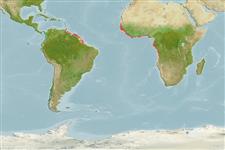Bivalvia |
Ostreida |
Ostreidae
Environment: milieu / climate zone / تغييرات عمق / distribution range
بوم شناسي
; لب شور. Tropical; 23°C - 31°C (مرجع 112235); 21°N - 24°S, 61°W - 14°E (مرجع 111917)
Atlantic Ocean: From Mauritania to Angola and from Venezuela to Brazil.
Length at first maturity / Size / Weight / سن
بلوغ: Lm ? range ? - ? cm
Inhabits the intertidal zone of rivers and estuaries (Ref. 101380). Also in mangrove estuaries where it is often associated with the air roots of mangrove trees, coastal rocks and stones (Ref. 101381). Often seen attached to the stilt roots of the red mangrove Rhizophora spp., fringing lagoons and estuaries (Ref. 106421). Also found on low subtidal level attached to rocks, shells, or stones on muddy sand bottoms (Ref. 109255). Oyster assemblage confers protection and food for various invertebrates and fishes (Ref. 101381). Filter-feeder, feeds on phytoplankton (green algae, diatoms, dinoflagellates) and substrate particles (Ref. 106999).
Life cycle and mating behavior
بلوغ | تولید مثل | تخم ریزی | Eggs | Fecundity | Larvae
Members of the class Bivalvia are mostly gonochoric, some are protandric hermaphrodites. Life cycle: Embryos develop into free-swimming trocophore larvae, succeeded by the bivalve veliger, resembling a miniature clam.
مآخذ اصلی
مراجع | هماهنگ كننده | همكاران
Ranson, G. 1960 Les Prodissoconques (coquilles larvaires) des Ostréidés vivants. Bulletin de l'Institut Océanographique (Monaco) 1183: 41 pp. (مرجع 83479)
وضعيت در فهرست قرمز IUCN
(مرجع 130435: Version 2025-1)
وضعيت از نظر سايتس (مرجع 108899)
Not Evaluated
Not Evaluated
خطر برای انسان ها
Harmless
استفاده انسانی
ماهي گيري – شيلات: تجاري
| FishSource | Sea Around Us
ابزارها
اطلاعات بيشتر
Life cycleتولید مثلبلوغFecundityتخم ریزیEggsنمو تخمLarvae PhysiologyOxygen consumption
Human RelatedStamps, coins, misc.
منابع اينترنتي
Estimates based on models
جهندگی
زياد, كمينه زمان لازم براي دو برابر شدن جمعيت ، كمتر از 15 ماه (K=0.65-1.9).
طبقه قيمت
Unknown.
Nutrients : Calcium = 149 [71, 228] mg/100g; Iron = 8.53 [1.95, 15.11] mg/100g; Protein = 9.88 [8.64, 11.12] %; Omega3 = 0.313 [0.202, 0.423] g/100g; Selenium = 61 [50, 72] μg/100g; VitaminA = 0 μg/100g; Zinc = 2.04 [0.56, 3.51] mg/100g (wet weight); based on
nutrient studies.
